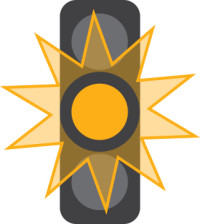There are give way rules that apply at intersections and driveways.
If you’re turning, give way to all traffic that’s not turning.


This includes giving way to cyclists using cycle and bus lanes, and vehicles using bus lanes.

It also applies when both vehicles are facing the same control, such as stop signs, give way signs and green traffic signals.



If you're leaving the path of a marked centre line at an uncontrolled intersection, you must give way to vehicles following the centre line.

This is because vehicles leaving the path of the centre line are legally turning, even though sometimes they might actually be going in a straight line, and the give way rules apply.
If you're turning right and the opposing vehicle is turning left, you must give way.




If you're on the terminating road (bottom of the T), give way to traffic on the continuing road (top of the T). This also applies at driveways.




You must give way to all traffic on the road and any road user on a footpath, cycle path or shared path.
In all other situations give way to your right. For example at a roundabout, an uncontrolled intersection or crossroads controlled by traffic signals when signals have failed and all approaches have a flashing yellow light.
The following rules apply at an intersection controlled by traffic signals – also known as traffic lights.
A red signal means stop.

A green signal means you can go, provided it's safe, and:

A yellow signal means stop, unless you're so close to the intersection you can’t stop safely. It means the lights will soon turn red.

A flashing yellow signal means the traffic signals aren't working. In this case, you must apply the give way rules.

When arrows are displayed on traffic signals, they apply only to vehicles going in the direction the arrow is pointing.
A red arrow means you must stop if you're travelling in the direction the arrow is pointing.

A yellow arrow means you must stop if you're travelling in the direction the arrow is pointing, unless you're so close to the intersection that you can’t stop safely.

A green arrow means you can go if you're travelling in the direction the arrow is pointing, provided it's safe.

The following examples will help you get to know what traffic signals and arrows mean.
Signal |
Vehicle path |
Action |
 |
Turning left | Must stop. The red arrow protects pedestrians crossing the road. |
| Straight through | May go, if it’s safe. | |
| Turning right | May go, if:
|
|
 |
Turning left | May go, if it’s safe. |
| Straight through | May go, if it’s safe. | |
| Turning right | Must stop, unless it's not safe to do so. | |
 |
Turning left | May go, if it’s safe. |
| Straight through | May go, if it’s safe. | |
| Turning right | May go, if it’s safe. All vehicles coming towards you or turning left should be stopped. |
At some intersections, there are special signals for cycles, trams and buses. Cycles, trams and buses can move when these signals are on, but all other vehicles must wait for the green traffic light.
A cyclist, moped or motorcycle rider lawfully using a bus lane may go when the white B light is showing.
